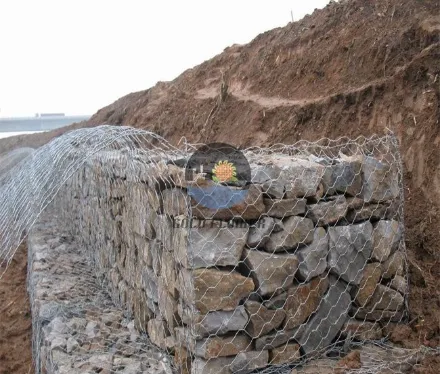Lug . 18, 2025 10:09 Torna alla lista
Constructing Functional Structures: The Art of Making Gabions
In the realm of civil engineering and landscape architecture, gabions have emerged as versatile and durable solutions for retaining walls, erosion control, and decorative installations. The process of making a gabion involves strategic use of materials like wire mesh and filler stones, while variants such as gabion mesh retaining wall, galvanized gabion, and galvanized/galvanised gabion baskets offer specialized benefits for different applications. This exploration delves into the techniques, materials, and practical uses of these structures, highlighting their role in creating robust and sustainable designs.

Understanding the Basics of Making a Gabion
The journey of making a gabion begins with selecting the right components: a wire mesh container (basket) and suitable fill material, typically rocks or stones. The mesh, often hexagonal or rectangular, is formed into boxes or cages that are then filled with aggregates. For a gabion mesh retaining wall, the baskets are stacked and interconnected, creating a flexible structure that adapts to ground movement while resisting lateral pressure. During construction, ensuring proper alignment and secure fastening between baskets is crucial to maintain structural integrity. Making a gabion also allows for creative designs, as the filler material can be chosen for aesthetic appeal, such as smooth river stones for landscape projects or rugged rocks for industrial applications.
Exploring the Utility of Gabion Mesh Retaining Walls
A gabion mesh retaining wall is a prime example of gabion functionality, combining strength with environmental benefits. These walls are built by arranging galvanized gabion baskets in layers, each filled with stones to create a permeable barrier. The mesh allows water to drain through, reducing hydrostatic pressure and minimizing the risk of wall failure due to moisture buildup. In hilly landscapes or areas prone to soil erosion, a gabion mesh retaining wall stabilizes slopes while promoting vegetation growth through the gaps in the mesh, enhancing ecological balance. The modular nature of these walls also makes them cost - effective, as individual baskets can be replaced if damaged without disrupting the entire structure.
Evaluating the Benefits of Galvanized Gabions
Galvanized gabion structures are prized for their durability, thanks to a protective zinc coating that shields the wire mesh from corrosion. This coating is particularly vital in harsh environments, such as coastal areas or regions with high humidity, where unprotected metal would degrade quickly. The galvanization process ensures that galvanized gabion baskets maintain their structural strength over decades, making them a reliable choice for long - term projects like bridge abutments or riverbank stabilization. Additionally, the flexibility of galvanized mesh allows gabions to conform to irregular terrains, simplifying installation in challenging landscapes without compromising performance.
Comparing Galvanized and Galvanised Gabion Baskets
The terms galvanized (American English) and galvanised (British English) refer to the same zinc - coating process, ensuring that galvanized/galvanised gabion baskets offer identical corrosion resistance. These baskets are available in various sizes and mesh openings, allowing customization for specific needs. Smaller mesh sizes are ideal for retaining fine gravel or creating decorative gabions, while larger meshes can accommodate bigger stones for heavy - duty applications like flood control. Regardless of spelling, galvanized/galvanised gabion baskets share the advantage of being eco - friendly, as they utilize natural stone fill and promote sustainable drainage, aligning with green infrastructure principles.
FAQ: Key Insights into Gabion Construction
What Materials Are Best for Making a Gabion?
For making a gabion, galvanized or stainless - steel wire mesh is recommended for durability. The mesh should have a minimum wire diameter of 2mm to withstand filler weight and external forces. Filler materials like limestone, granite, or recycled concrete are suitable, with stones sized between 75mm and 150mm to ensure proper interlock within the basket. Avoid using rounded stones, as angular aggregates provide better stability.
How to Ensure Stability in a Gabion Mesh Retaining Wall?
Stability in a gabion mesh retaining wall depends on proper installation. Start with a compacted gravel base to distribute weight evenly. Stack baskets in staggered rows, using wire ties to connect adjacent units and create a unified structure. Fill each basket to 90% capacity to prevent bulging, and compact the stone fill gently to eliminate voids. Adding geotextile fabric behind the wall can further reduce soil migration and enhance drainage.
What Maintenance Is Required for Galvanized Gabion Baskets?
Galvanized gabion baskets require minimal maintenance due to their corrosion - resistant coating. Periodically inspect for physical damage, such as bent mesh or displaced stones, and repair promptly by replacing damaged sections or refilling loose filler. In coastal areas, rinse baskets with fresh water annually to remove salt deposits, though the galvanized layer typically withstands such environments for 20–30 years.
Can Gabions Be Used for Decorative Purposes?
Yes, making a gabion for decoration is popular in landscaping. Choose colorful or textured stones for the fill, and use smaller baskets to create planters, garden edging, or artistic installations. Welded wire mesh with a tighter weave can even be shaped into custom forms, such as seating walls or fence panels, combining functionality with visual appeal.
Are Galvanized Gabions Environmentally Friendly?
Absolutely. Galvanized gabions are eco - conscious solutions, as they use natural, locally sourced stone fill, reducing the need for energy - intensive building materials like concrete. Their permeable design supports groundwater recharge and provides habitats for small plants and insects, promoting biodiversity. Additionally, the zinc coating in galvanized mesh is applied through an environmentally regulated process, ensuring minimal impact during production.
condividere
-
What Are the Key Applications and Benefits of Chicken Wire Gabion and Related Retaining Solutions?
NotiziaJul.18,2025
-
What Are the Key Advantages and Applications of PVC Coated Gabion Wire Mesh and Related Solutions?
NotiziaJul.18,2025
-
Welded Gabion Mesh Solutions: Strength and Versatility in Construction
NotiziaJul.18,2025
-
Essential Solutions for Slope Stability: A Focus on Protective Nets
NotiziaJul.18,2025
-
Durable Solutions for Erosion Control and Construction: Galvanised Gabion Systems
NotiziaJul.18,2025
-
Constructing Functional Structures: The Art of Making Gabions
NotiziaJul.18,2025

